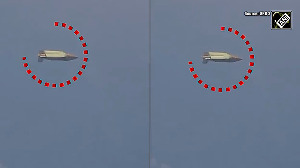According to a research report by Equitymaster, the paints sector is valued at Rs 95 billion and is very fragmented. The current demand is estimated to be around 6,50,000 tonnes per annum and is seasonal in nature.
The per capita consumption of paints in India stands at 0.5 kg per annum as compared to 1.6 kg in China and 22 kg in the developed economies. India's share in the world paints market is just 0.6 per cent.
The unorganised sector controls around 35 per cent of the paints market, with the organised sector accounting for the balance. In the unorganised segment, there are about 2,000 units having small and medium sized paints manufacturing plants.
Top organised players include Asian Paints (44 per cent market share), Kansai Nerolac (20 per cent), Berger Paints (17 per cent) and ICI (12 per cent). The organised sector has grown at a CAGR of 11.5 per cent in the last five years.
Infrastructure investment and thriving construction activity had helped the paints industry attain an average growth of 8-9 per cent in the last four years.
Higher growth in the decorative paints segment, driven by the construction and housing boom, is likely to push growth in the paints segment further. With the decorative segment accounting for about 75 per cent of the Indian paints market, the performance of the sector would hinge on demand from the housing sector.
Reduction in excise duty rates over the years has led to an increase in the share of the organised sector players in the paints industry, as lower duties bring down the price advantage enjoyed by unorganised players.
While higher level of construction activity is pushing up demand for paints used in the housing sector, replacement demand for paints is a function of the purchasing power and can be correlated with the growth in gross domestic product (GDP). Thus paint companies stand to benefit both from the general economic growth and increased housing activity.
Growth in infrastructure would directly benefit industrial paints sales, which can be expected to grow at a rate higher than sales of decorative paints. However, this would be subject to availability of funds for infrastructure as well as the necessary clearances and timely project execution skills.
The roads and highways sector is also expected to generate good demand as the National Highways Authority of India (NHAI) would be building roads at a cost of Rs 1,700 billion over the next decade.
According to Equitymaster, decorative paints account for over 75 per cent of the overall paints market in India.
Major segments in decoratives include exterior wall paints, interior wall paints, wood finishes and enamel, and ancillary products such as primers and putties. Asian Paints is the market leader in this segment.
Demand for decorative paints arises from household paintings, architectural and other display purposes. The demand in the festive season (September-December) is significant, as compared to other periods. This segment is price sensitive and is a higher margin business as compared to the industrial segment.
In the industrial sector, the three main segments include automotive coatings, powder coatings and protective coatings, and is far more technology intensive than the decorative segment.
The industrial paints market-size stands at around Rs 9.5 billion with Kansai Nerolac being the market leader. User industries for industrial paints include automobiles, engineering and consumer durables.
In the decorative paints segment, the market is dominated by Asian Paints, while Goodlass Nerolac is leader in automotive paints.
SNIPPETS
Tax relief
Budget 2007-08 has come as a window of relief for paint companies with the finance minister announcing that customs duty on titanium dioxide and pigments and preparations based on titanium dioxide would be cut from 12.5 per cent to 10 per cent.
Titanium dioxide is a key input in the paints industry and makes up 12-15 per cent of the total raw material costs. Titanium dioxide is used to provide whiteness and opacity to products such as paints.
The current global spot price of titanium dioxide stands at $2,000 a tonne. The Rs 10,000 crore domestic paints industry is estimated to have imported raw materials worth Rs 1,800 crore annually.
According to a Crisil analysis, this year's budget is also expected to have a positive impact on the decorative segment, and a marginally positive impact on the industrial segment.
The reduction in peak customs duty on titanium dioxide from 12.5 per cent to 10 per cent, and phthalic anhydride and pentaerythritol from 12. 5 per cent to 7.5 per cent would reduce raw material costs, thereby increasing operating margins by 40-50 basis points.
Players who cater to this industrial segment are expected to benefit more, due to the higher import content of raw materials. However, they are expected to pass on a significant portion of this benefit, due to lower bargaining power. The reduction in peak customs duty on paints will not affect the industry.
Problem areas
The paint sector is highly raw material intensive. With over 300 raw materials (30 per cent petro-based derivatives) involved in the manufacturing process, any rise in crude and petrochemical prices would affect the industry.
Since most of the raw materials are petroleum based (e.g. Titanium Dioxide), the industry would benefit from softening crude prices.
With the steady decline in excise duties (from 40 per cent to 16 per cent in the last five years), the viability of small-scale units has eroded considerably.
Without any price advantage, these units have found it difficult to compete with their peers in the organised sector. The unorganised sector has been consistently losing market share to the organised sector.
Moreover, an increasing number of consumers demand improved quality today, which could work to the advantage of organised sector players. Competition in the paints market is also expected to intensify, but a change in the pecking order is not expected immediately.
In the industrial segment, the emergence of multiple players in the car market has made the market more competitive for paint manufacturers. All players in the paints industry are scrambling to develop their links with foreign paint companies to satisfy consumers.






 © 2025
© 2025